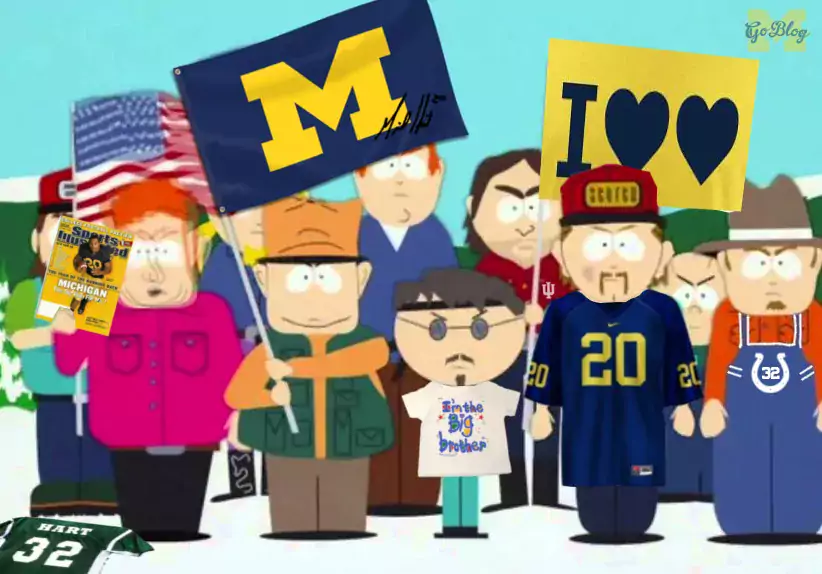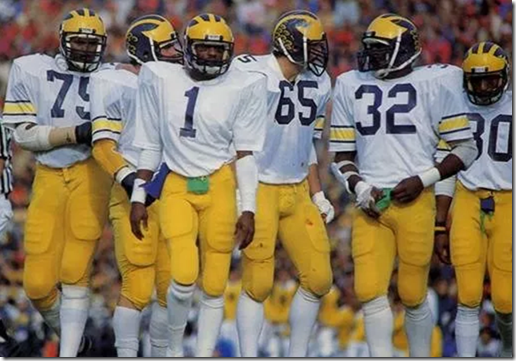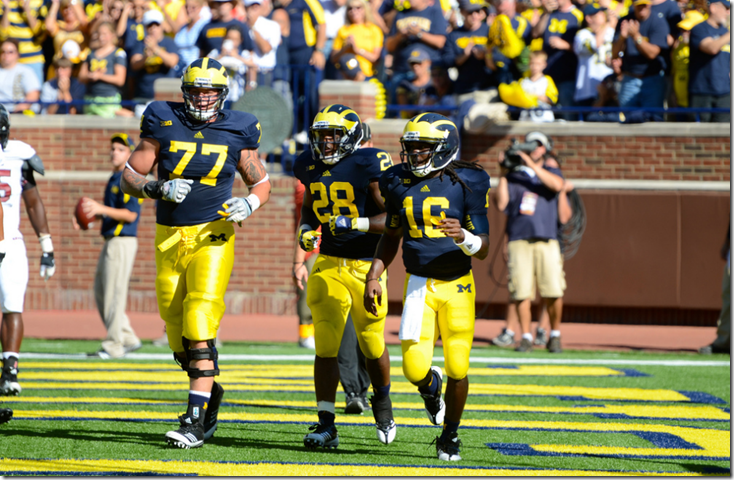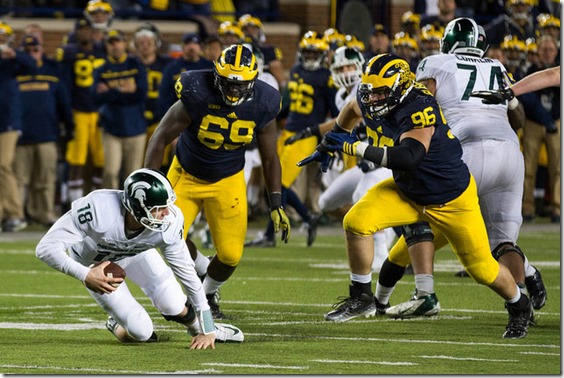1980 purdue

Last offseason I was making these Michigan All-____ Teams and I didn't get around to all of the ideas. So let's.
Previously:
- Ancient History: 1879 to 1968
- The 5-stars
- The 3-stars
- The Extracurriculars
- Position-Switchers
- Highlights
- All-Numbers Team Part I: The Offense
- All-Numbers Team Part II: The Defense
- The Best of Michigan (the state)
- All-Name Team
Today's Rules: You must be in the bottom quartile of height for your position and get extra points for being shorter than that. Weight doesn't matter as much as height (because most of these guys had to add a lot of it). Also this has to be relative to the players of your era—with a heavy recency bias—because there was a time when a six-foot offensive tackle was considered huge. For example, here's 5'11" Anthony Carter with some of the other 1979 offensive starters (via a Dr. Sap article on MVictors):
I'm going to use my discretion as we go, but if a player wasn't remarkably tiny for his era, even if he would be in ours, he doesn't count.
The problem: Rosters lie, especially regarding these players, because listing a short guy at his real height could depress his pro future. Where I have knowledge of a guy's actual height I'll use that, and beyond that I'm just going to do my best.
Quarterback: Denard Robinson
Last listed size: 6'0"/197 (2012)
[Brian Fuller]
Strangely, 2019 recruit Cade McNamara, at 6'1", is the third-shortest Michigan scholarship quarterback since Bo, with Denard and 2008 proto-Denard Justin Feagin both listed at a straight six. Or maybe that's not so strange because height in a quarterback is so highly valued. In my opinion it's highly overrated; the last two Heisman winners were Oklahoma quarterbacks listed at 6'0" and 5'11", QED. Notably, despite Michigan's clear preference for tall guys, some of their best were all on the shorter side, including Chad Henne and Shea Patterson, both just 6'2". Anyway, the rosters lied about Denard's height, which was probably 5'11" or just under it. I should mention the 2011 roster lists Denard as 5'9", which is wrong but feels right. His height led to a few batted balls, but since his center also appears later on this list (and Ricky Barnum wasn't very tall either), and because defenders in space had to approach warily lest Denard escape the pocket, the % of batted balls from Denard in the UFRs is lower than that for Henne.
Honorable Mention: Dennis Brown (5'10"/175), Tate Forcier (6'1"/190), Harry Newman (5'7"/174), Boss Weeks (5'7"/161) lots of other old dudes. Michigan's first great quarterback (and college athletics' first great athletic director) Charles Baird was listed at 5'6". Michigan's shortest QB on the Bentley database was 1914-'16 bencher Harold Zeiger, at 5'4".
[After THE JUMP: Not who you think]

Michigan historian Dr. Sap and I have started a new podcast on the lore of Michigan football. The plan is to bounce around doing one season per episode, talking about the players, the games, that year's place in the pantheon of Michigan teams, and usually having one segment with a guest.
The Sponsor:
It is sponsored by HomeSure Lending. If you're buying or refinancing your home, this is the guy to talk to. He'll work on your loan directly and walk you through a process that can get really confusing really fast. He did my loan, Brian's loan, and a lot of MGoBlog readers' loans.
--------------------------------------------
1. The Recipe to Win
starts at 0:40
Coming off a disaster of an end to 1979 and major changes on the roster and coaching staff, the 1980 team started off with two nonconference losses and ended as Rose Bowl champs. We talk about how stodgy old Bo learned to adapt to the strange new landscape of modern football, extending his magnificent career into a very different decade than the one he'd just dominated.
2. Interview with 1980 Team Captain Andy Cannavino
starts at 33:33
Andy tells how the locker room problems hit their worst point in the 1980 preseason, when five players were kicked off the team for marijuana and John Wangler was knocked out by Lawrence Taylor. How do you come back from that? Well, grousing about practicing too hard didn't do the trick, but hollering at Andy Cannavino appeared to.
3. 1980 in Context
starts at 57:27
Team MVP, most important moment, etc., but mostly this segment talks about what kind of team 1980 was and how it compares to 2018 and some of the other seasons that began on a down note but accomplished far more than they thought possible.
MUSIC
- "NBC Rose Bowl Theme"
- “Across 110th Street”
THE USUAL LINKS
- Helpful iTunes subscribe link
- General podcast feed link
- Direct download link (right-click/save-as)
- What's with the theme music?
[Eric Upchurch]
Inclusions and omissions. PFF lists its top 101 players going into 2016 and Michigan's defense is well represented:
- #7 Jourdan Lewis
- #16 Jabrill Peppers
- #27 Maurice Hurst
- #31 Chris Wormley
- #72 Ryan Glasgow
We knew most of this already since Hurst was projected as a first round pick by PFF and Glasgow came in for mention as a top-20 DL a year ago. This is some more detail on Glasgow:
Another standout performer on the Michigan defensive line, Glasgow played only 332 snaps before going down to injury in Week 10. He posted a dominant +17.6 grade against the run to go with a +9.0 pass rush grade and his overall grade ranked 19th in the nation at the time of the injury.
Losing him was a crushing blow to the run D.
PFFs omissions are illuminating and one jumps out: Jake Butt. This might point to a hole in PFF's methodology. Their list doesn't have a single TE on it. IIRC when they mentioned Butt in the past they had negative grades for his blocking, which is reasonable since he was very much a finesse guy a year ago. It seems like TE blocking should probably be graded on a curve since a guy like Butt helps out the run game in other ways due to his threat as a pass catcher.
Anyway, there are three Michigan DL amongst the best in the country… and one of them probably isn't going to start. Add in Charlton, Mone, and Gary and this line is set to be an all-timer.
Speaking of Glasgow. He tells Nick Baumgardner he's almost all the way back:
Glasgow -- who posted 25 tackles (5 for a loss) -- says about 95 percent of his shoulder strength has returned. And if Michigan were to start fall camp tomorrow -- it'll begin Aug. 8 -- then Glasgow would be full-go without any limitations.
"There might be some rust with technique and stuff. But (I'd be healthy and ready)," Glasgow added. "Being out on the field is amazing. I definitely took it for granted before and I never will ever again now. That injury definitely sobers you up to the fact that football does have an end date. Which is unfortunate.
"But it makes you appreciate the game."
If Glasgow does get displaced by Mone I'll be shocked. Not lemon-eating shocked. But shocked.
Oakland is not in play. "Off to NFL in three years" futures are cratering:
“Happy, happy—10 out of 10 happy,” he says. He juggles a pair of camps and time with a number of recruits here on unofficial visits. “And then I get to walk over to the stadium and do the offensive and defensive linemen too! You’re like a pig in slop out here. That’s how I feel. Drawing the long straw today.”
Purdue 1980. Via Dr. Sap:
Better than nothing. John O'Korn hit up the Manning passing camp and came away with a prestigious award:
Southern Mississippi’s Nick Mullens and Michigan’s John O’Korn were crowned co-champions of the Air-it-Out Quarterback Challenge after neither could separate themselves after five rounds of competition at Nicholls State University's stadium. …
During the passing challenge, the quarterbacks had to hit three golf carts traveling across the field at 15 yards, 25 yards and up the sidelines. This was a change from previous years, when the first two carts traveled 10 and 20 yards. Quarterbacks needed to hit all three carts to advance.
A prestigious award based on approximately a dozen throws, so don't print up your O'HEISMAN 2016 t-shirts just yet. Like the increasingly farcical Elite 11—which had 24 QBs at it this year—the more QBs that get thrown in a passing camp bucket, the less reliable the outcomes are. Still, as the bold bit says, better than nothing.
Fulton on OSU. You won't find a better primer on the Buckeyes than that delivered by Ross Fulton. This part is especially relevant to Michigan fans because M will run the same style of front-seven defense:
Ohio State features a Mike, Will, and Sam linebacker. But what does that mean? It is helpful to think of Ohio State using two inside linebacker and one outside linebackers.
The Mike and Will are the inside linebackers. They are primarily responsible for an inside run gap to their side of the formation. The Mike plays to the field, with the Will to the boundary. There are slight differences. The Will must be rangier because he more often has boundary flat coverage responsibilities. The Mike is a more traditional downhill inside linebacker.
But the Mike and Will are more interchangeable than the Sam. The Sam – or Walkout –linebacker is a hybrid linebacker/safety. As the name suggests, the walkout linebacker often plays outside the tackle box, generally aligning over the number 2 or slot receiver. Playing in space, he is responsible for setting the edge to the field, meaning he must be able to defeat blocks and force the football inside.
Practically speaking, this means the position is responsible for limiting the horizontal screen and run game that feature prominently in spread offenses. But he must also be comfortable playing in the tackle box against pro-style formations. In short, the position requires perhaps the most versatile player in the Ohio State defense.
The SAM is obviously Peppers and the stuff he'll be asked to do isn't too much different than his job last year. Brown will incorporate a lot more blitzing and zone coverage into the Peppers role; he'll still be Michigan's screen obliterator.
Got some guys this year. NFL.com is releasing lists of the top ten players to watch at various positions. Michigan guys are popping up with frequency. Jehu Chesson is the #2(!) WR:
2. Jehu Chesson, Michigan
Some receivers just carry themselves like a natural-born WR1 and Chesson is one of those guys. There is a level of confidence and toughness that comes through when you watch him play, and he is as fearless a wide receiver when working in traffic as any you will find, taking shot after shot while securing the catch. Stat scouts won't fall in love with Chesson based on his production last season (50 catches for 764 yards and 9 TDs), but NFL scouts love his ability to adjust to throws and work all three levels of the field. He won't have many "Wow!" highlights that have you jumping out of your seat, but his size, toughness and consistency put him near the top of this list.
This gentleman must not have watched the bowl game. Jake Butt is the #2 TE, Mason Cole the #6 interior OL.
MSU gets a sixth year. OL Brandon Clemons got his sixth year:
Michigan State OL Brandon Clemons got his sixth year approved by the NCAA today. Expected, but needed boost of experience nonetheless.
— Dan Murphy (@DanMurphyESPN) June 21, 2016
Some guy on the internet went back and checked dress lists, finding that Clemons was in street clothes by the end of the year and may actually have a case. Ed Davis almost certainly does not:
He dressed in every game, including road games where the travel team is limited. There's no way he didn't take a voluntary redshirt.
Next year's NHL draft prospects. Michigan didn't have a player selected in the first round despite a banner year for NCAA hockey, especially a BU team that will be loaded when it comes to Yost this fall. That should change next year. Chris Dilks's initial rankings for 2017 feature three Wolverines-to-be: #15 Michael Pastujov, #25 Josh Norris, and #28 Luke Martin. Martin is arriving this fall, so Michigan kind of sort of maybe has a first rounder in this recruiting class.
What are you doing, MSU hockey? They just don't care.
Also on the agenda are the renewals/extensions of contracts for Athletic Director Mark Hollis through the 2020-21 school year and three of his major-sport coaches – men’s basketball coach Tom Izzo (2022-23), women’s basketball coach Suzy Merchant (2020-21) and hockey coach Tom Anastos (2019-20).
A hockey coach's buyout is chump change for a Big Ten athletic department but I'm just like… why? Why are you the way you are?
Etc.: Basketball recruiting is ridiculous.



![pwvlt0vg2plgwamp7wfi[1] pwvlt0vg2plgwamp7wfi[1]](http://mgoblog.com/sites/mgoblog.com/files/mgoupload/84726e73caab_967D/pwvlt0vg2plgwamp7wfi1_thumb.png)
![2011_august_davis_healthy[1] 2011_august_davis_healthy[1]](http://mgoblog.com/sites/mgoblog.com/files/mgoupload/84726e73caab_967D/2011_august_davis_healthy1_thumb.jpg)
54